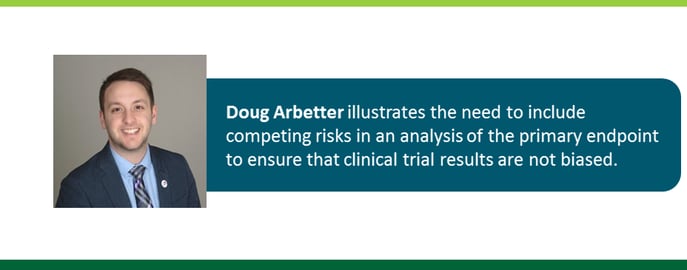1 min read
ASH Annual Meeting and Exposition
Meet Veristat at ASH Meeting and Exposition December 6-9, 2025
Veristat is excited to attend the ASH Annual Meeting and...

In pharmaceutical clinical trials, considering competing risk analyses is highly important. Competing risks are events that may occur and prevent the evaluation of a specific primary endpoint, in turn biasing risk estimations or drug efficacy.
Traditional time-to-event analyses, such as the Cox Proportional Hazards model, may overestimate event rates as censored subjects will disproportionately contribute to the numerator by taking them out of the denominator of the at risk population.
Recently, one of Veristat’s Associate Biostatisticians published a manuscript on this topic that evaluated non-venous thromboembolism (VTE)-related death as a competing risk in a cardiovascular clinical trial assessing the efficacy of extended-duration betrixaban versus standard dosing enoxaparin in reducing symptomatic VTE events. To account for competing risks, the authors used the Fine and Gray method, which uses a cumulative incidence function instead of Kaplan-Meier to keep those who experience a competing risk in the denominator and appropriately weighting their survival time.
We encourage you to read the abstract below, and you’re welcome to follow the link provided to the full manuscript.
Competing Risk Analysis in a Large Cardiovascular Clinical Trial: An APEX Substudy.
Arbetter DF1, Jain P1, Yee MK1, Michalak N1, Hernandez AF2, Hull RD3, Goldhaber SZ4, Harrington RA5, Gold A6, Cohen AT7, Gibson CM1.
Pharmaceutical Statistics 2017 August 24
Competing risk methods are time-to-event analyses that account for fatal and/or nonfatal events that may potentially alter or prevent a subject from experiencing the primary endpoint. Competing risk methods may provide a more accurate and less biased estimate of the incidence of an outcome but are rarely applied in cardiology trials. APEX investigated the efficacy of extended-duration betrixaban versus standard-duration enoxaparin to prevent a composite of symptomatic deep-vein thrombosis (proximal or distal), nonfatal pulmonary embolism, or venous thromboembolism (VTE)-related death in acute medically ill patients (n = 7513). The aim of the current analysis was to determine the efficacy of betrixaban vs standard-duration enoxaparin accounting for non-VTE-related deaths using the Fine and Gray method for competing risks. The proportion of non-VTE-related death was similar in both the betrixaban (133, 3.6%) and enoxaparin (136, 3.7%) arms, P = .85. Both the traditional Kaplan-Meier method and the Fine and Gray method accounting for non-VTE-related death as a competing risk showed equal reduction of VTE events when comparing betrixaban to enoxaparin (HR/SHR = 0.65, 95% 0.42-0.99, P = 0.046). Due to the similar proportion of non-VTE-related deaths in both treatment arms and the use of a univariate model, the Fine and Gray method provided identical results to the traditional Cox model. Using the Fine and Gray method in addition to the traditional Cox proportional hazards method can indicate whether the presence of a competing risk, which is dependent of the outcome, altered the risk estimate.
This article is available through PubMed.gov. Please note that you will need to have a subscription to access the full article.
If you are interested in speaking with us to learn more about this article, speak with the author or learn more about our services, 
 Doug Arbetter, MPH,
Doug Arbetter, MPH,
Associate Biostatistician, Veristat
Doug is an experienced Biostatistician having conducted analyses of clinical trial data for large scale international clinical trials. He specializes in Cardiovascular clinical trial data analysis. Prior to Veristat, he worked at the PERFUSE Research Group at Beth Israel Deaconess Medical Center.
1 min read
Oct 22, 2025 Veristat Events
Veristat is excited to attend the ASH Annual Meeting and...
2 min read
Oct 17, 2025 Veristat Events
Veristat is proud to participate...